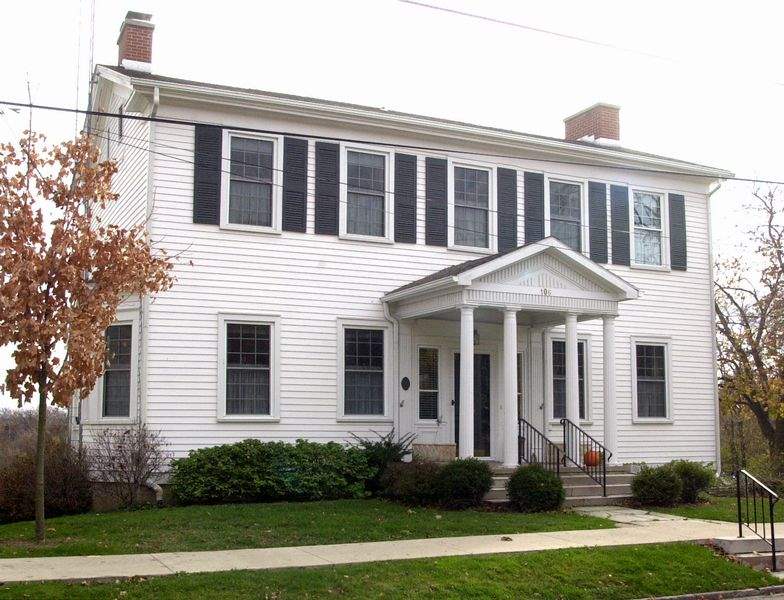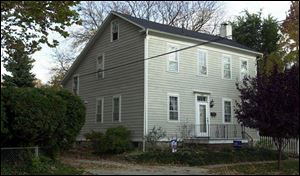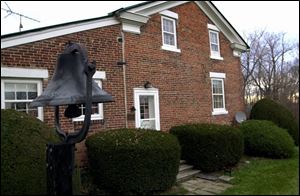
Relics live on as living spaces
11/12/2000
The house at Conant and East Harrison is circa 1825.
The lower level that was built to house livestock in the rear of Craig Van Horsten's Maumee house is now a kitchen and dining room.
The inside was redone in the 1920s, when an interior decorator owned the property.
But the symmetrical brick house built into the side of a hill at 312 West Harrison St. is among the area's oldest houses that are thought to have remained remarkably as they looked when they were built some 175 years ago. The area's oldest houses are clustered in Maumee, Perrysburg, Waterville, and Monroe County.

Records say 208 Elizabeth in Maumee was built in 1827.
Others from that era have been remodeled repeatedly, changing architectural styles. Some early log cabins have been added onto so often that they are enclosed in large houses, almost indistinguishable from far newer buildings both inside and out.
Exactly how old the area's oldest houses are and how much they have been changed makes far less difference to the local real-estate market than it does to historians and to the bragging rights of property owners, however.
“I don't know that the year it was built is that much of a come-on,” said Jean Morgenroth, a real-estate agent with Zachman & Associates, Inc.
Unlike with other antiques, for which value often directly correlates to age, few area old-home buyers seem to make decisions based on whether a building is thought to be about 175 years old or simply 100 years old, agreed Michael Miller, owner of Sulphur Springs Realty, Inc.

The house at Conant and East Harrison is circa 1825.
The exact age of buildings is such a low consideration in the values county auditors assign to properties that many say they have not made maintaining ages of buildings a priority.
A house's location and condition surpass age in importance, said Tom Salsberry, a vice president at Danberry Co. Realtors. In recent years, he said, more families looking at houses have two incomes and less time that they want to devote to renovating homes of any age.
A smaller percentage of home buyers now than a few years ago ask to look at old houses, Mr. Miller said. That probably is because the recent construction boom gives buyers more choices of new homes on the outskirts of Perrysburg, Maumee, and other old areas.
Still, tours of old homes appear to be more numerous and more popular than ever across the Midwest, said Hank Prebys, curator of domestic life at Henry Ford Museum and Greenfield Village. He said he's heard of about 25 old-house tours in the Detroit and Toledo areas alone.
The highest prices for Lucas and Wood County's oldest houses tend to be in Perrysburg, followed by Maumee and Waterville, Mr. Miller said. Vistula, in central Toledo, has far fewer of its original homes remaining and prices are much lower, real estate agents said.
Amazingly, at least half of the houses in Perrysburg and Maumee that were built by 1830 remain in use, said Ted Ligibel, director of the historic preservation program at Eastern Michigan University. He has researched thousands of area buildings.
In most areas of Ohio and Michigan, fewer than 20 per cent of the earliest homes are still standing, Mr. Prebys said.
Maumee was home to preservationists in the 1920s to 1940s who wanted to restore old buildings that had housed common people, Mr. Ligibel said. At that time, many areas cared only about preservation of the homes of early patriots or others who were considered important.

This circa 1824 Monroe County home was built by a mason.
It is almost impossible to say exactly how many houses from the years immediately after white settlers came into the area remain in use. The Lucas County auditor's office counts 33 built between 1817 and 1849. Of those, a dozen are in Maumee and five are in Waterville.
Area historians say some on that list probably are not that old, however, and Mr. Ligibel cautions that definitive records on the area's housing were almost nonexistent before the Civil War.
When the oldest local houses were built, Wayne County in northeast Ohio extended through much of the Toledo region, and some of the area was part of Michigan's Monroe County.
For years, county records did not list buildings, and historians are left to track sharp increases in property values and guess at whether they reflect the presence of a house or simply a jump in local land prices.
The accuracy of auditor records varies greatly from county to county.
Lucas County claims to have tried to maintain exact records, but Jerry German, the chief assessor, said many dates on the oldest houses are estimates gathered decades ago from property owners and neighbors.
In Sandusky County, the auditor's office uses the date of 1900 for all houses thought to be built that year or before. In many counties, the oldest houses are simply listed as “old” on auditor records.
The histories that area residents recall hearing from previous generations usually have at least a nugget of truth, but aren't always reliable, Mr. Ligibel said.
The Maumee house at 312 West Harrison St., for example, was built right after the war of 1812, according to local folklore. The war ended in 1815, which would jibe with the Lucas County auditor's date of 1818 for the house. But in Mr. Ligibel's book of landmark historic architecture, Lights Along the River, the date of the house often called Elm Cottage is hedged at circa 1830.
Such old houses are in greater numbers in some small cities because the land upon which they sit never became as valuable as it might in a larger city.
“The houses that were first built were not usually grand houses, so if it were a great location, that original house may be torn down and something else built in the place of it when someone had more time and money,” Mr. Prebys said.
Old houses were most likely to be torn down in economic boom times, such as the 1880s and 1890s when many were removed in Waterville to make way for the commercial district, Mr. Ligibel said. At that time, even the oldest houses were less than 75 years old and seldom were considered historic.
Even houses that have remained much as they were built have undergone substantial changes. All would have been built with wooden roof shingles that might have lasted 40 to 50 years if they were well maintained.
Some old houses have tin roofs that have been painted over the years, including one on an addition to Peg Clark's house in Monroe County's Frenchtown Township. The house was thought to have been built in about 1824, added onto in 1861, and renovated in 1945 when the tin roof might have gone on.
Glass was not used in windows of some of the earliest houses until after the canals, on which cargo could be hauled, were constructed.
Original floors made of painted random-width boards were considered very old-fashioned in the late 1800s, and many were replaced at least on first floors by narrower, tongue-and-groove boards that lay flatter, Mr. Prebys said. Almost all porches on the oldest area houses were later additions.
The most expensive old houses sometimes had mud or brick as insulation in the walls, which often remains, Mr. Prebys said.
Unless they have been extensively remodeled, old houses often lack clothes closets and have tiny bedrooms, which are problems to some prospective buyers, said Mr. Salsberry of Danberry.
He said he tells such people that it's easier to build a new house in an old style.